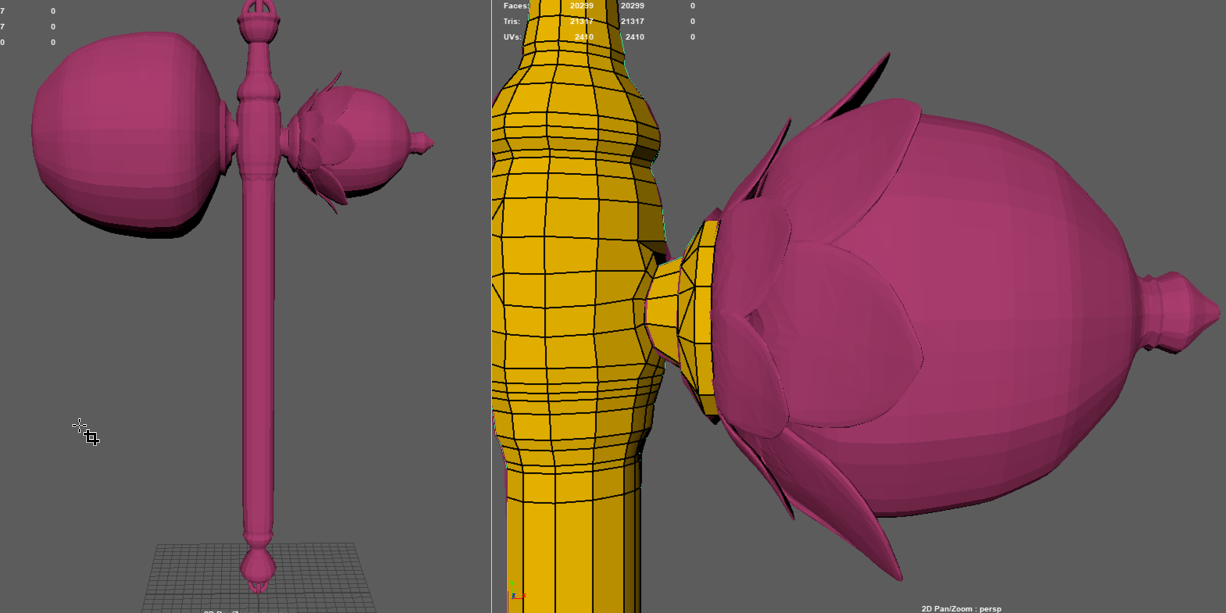The BRAWL² Tournament Challenge has been announced!
It starts May 12, and ends Oct 17. Let's see what you got!
https://polycount.com/discussion/237047/the-brawl²-tournament
It starts May 12, and ends Oct 17. Let's see what you got!
https://polycount.com/discussion/237047/the-brawl²-tournament
New to Retopology- Advice needed on some stuff!
Hi everyone,
So like the title says, I'm new to retopologizing things- I'm not totally new to 3d, but I'm new to optimizing things for games and whatnot.
On the right is the model I've made- the base of the hammer was done in Maya and the petals were added in Zbrush. I brought it back to maya to retopo, but I'm confused on how to tackle topology like this. The goal for me is to learn how to properly optimize for game assets so I don't want to just decimate/zremesh- I want to learn how to do it properly.

I've been looking at the image below as an example of something similar (protrusions on protrusions) but I have NO idea how the transparencies happened between the low outermost 'feathers'.

Any advice or examples would be greatly, greatly appreciated.
Thanks for reading!
So like the title says, I'm new to retopologizing things- I'm not totally new to 3d, but I'm new to optimizing things for games and whatnot.
On the right is the model I've made- the base of the hammer was done in Maya and the petals were added in Zbrush. I brought it back to maya to retopo, but I'm confused on how to tackle topology like this. The goal for me is to learn how to properly optimize for game assets so I don't want to just decimate/zremesh- I want to learn how to do it properly.

I've been looking at the image below as an example of something similar (protrusions on protrusions) but I have NO idea how the transparencies happened between the low outermost 'feathers'.

Any advice or examples would be greatly, greatly appreciated.
Thanks for reading!
Replies
I would definitely agree with musashidan, the silhouette is one of the most important things when retopologizing a mesh. Judging from your right picture, I'd say you've got a good beginning going.
Also, for all your texture map information needs:
http://wiki.polycount.com/wiki/Texture_types
There's a pretty extensive section on opacity/transparency maps.
Super thanks
2 outer edges vs 1.
Of course if you don't need those leaves to be part of the silhouette then conform them to the surface so they can be captured in a simple spherical shape, but they can't stick up that high and be rendered down to a simple shape. So either the low poly supports the silhouette or the high poly needs to come down and fit within the low poly space.
Would you by any chance happen to have an resources on what goes into baking transparencies (like in the case of the example I posted)? I've been scouring the internet and I've gotten a little bit of a handle on what's happening, I know the concept for plants and such-but I'm still having a little trouble grasping exactly HOW they managed to get (what looks like) legit geometry out of a plane.
This is a pretty solid overview of how geometry and the resulting maps can be treated for grass and other plants:
https://80.lv/articles/tutorial-grass-creation-for-games/
More in-depth walk throughs:
http://wiki.polycount.com/wiki/Foliage
In terms of resources for baking transparencies, much of the workflow will be exactly the same as baking any other map. But like all maps, there are some special cases (such as the first grass example above) where it could be slightly different. Not sure how deep you've gone down the baking rabbit hole yet, but this is always a great place to start:
http://wiki.polycount.com/wiki/Texture_Baking
Getting the result in your example is (and someone correct me if I'm wrong) similar to the technique used when baking trim sheets for environments. I can't remember where the example I'm thinking of is, but there is definitely more info on it here:
http://wiki.polycount.com/wiki/Modular_environments
Having said all that, I'm going to second Mark's above demonstration when it comes to the shapes on your hammer. It seems like they would really benefit from the thickness.